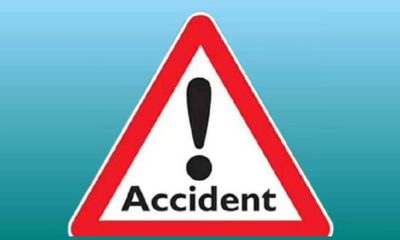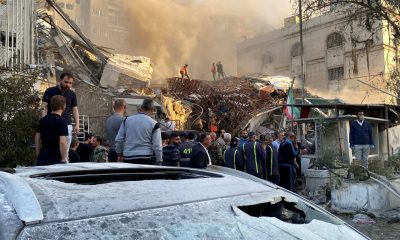Comments and Issues
Imo guber: Justice under scrutiny
Published
4 years agoon
By
Olu Emmanuel
It is no longer breaking news that, by a judicial fiat issued on January 14, 2020, the Supreme Court ousted the elected Governor of Imo State, Rt. Hon. Emeka Ihedioha, ordered issuance of a certificate of return “forthwith” to Hope Uzodinma and that he (Uzodinma) be sworn in “immediately.” Uzodinma came fourth in the result declared by INEC, the electoral umpire. Perhaps more topical now is a serious allegation, which a civil society organisation has recently made that the certified true copy (CTC) of the judgement released by the Supreme Court a full eight days after the judgement differs in certain respects from what was delivered in court, a serious allegation which the National Judicial Council and all stakeholders in the justice delivery sector must look seriously into. That, however, is not the thrust of this piece.
Some Nigerians, lawyers and non-lawyers, have raised some points from their analyses of the judgement, and put the blame on INEC for not vigorously defending the allegations. However, the problem is that one cannot properly interrogate that judgement by merely looking at what the Supreme Court said in their judgement.
I have had the privilege of studying and analyzing both the tribunal and the Court of Appeal judgements. I have equally gone through the record of appeal, and I can tell you that I have serious doubt if the Supreme Court actually had time to take more than a cursory look at it. That is the best concession that one, honestly, can make to that great court. This is because, if they did, the conclusion that they ignored what should have made the judgement go the other way would become inevitable.
For those who know how the system works, there is also another redemptive but hidden exculpation for the justices. The tribunal judgement is 145 pages, and the Court of Appeal judgements are made up of 68 pages of the majority and 63 of the dissenting (minority) judgement. The proceedings in the tribunal and in the Court of Appeal, the processes filed and the motions make up the almost 3,000 pages of the record, bound in volumes.
One poignant point highlighted is the new coinage, which the lead judgement introduced into Nigerian jurisprudential lexicon. It is “original duplicates.” The Evidence Act 2011, in Section 86(1), defines “primary evidence” as “the document itself produced for the inspection of the court.” Section 86(2) and (3) goes further to include each part of “documents executed in several parts” and every counterpart of a document “executed in counterparts” as constituting primary evidence and, therefore, admissible as original.
Is a duplicate original? Is it a counterpart? The attitude of the courts has been that duplicates are secondary evidence. Where there is a duplicate, an original exists. A duplicate is done by using carbon under the original. A duplicate supposedly captures each letter or word exactly the same way and pattern it is on the original.
I think that the second part of Section 86(4) settles this matter. Section 86(4) of the Evidence Act 2011 states: 86 (4) Where a number of documents have all been made by one uniform process, as in the case of printing, lithography, photography, computer or other electronic or mechanical process, each shall be primary evidence of the contents of the rest; but where they are all copies of a common original, they shall not be primary evidence of the contents of the original.
The danger of according a duplicate the status of an original is that, on a form, like the INEC Form EC8A, a false original may be placed on top to produce a forged duplicate and then touted as a duplicate of the original. This is the more reason it is necessary to have certification on the duplicate if you claim that the duplicate is that of an original of a public document.
The Form EC8As, which Uzodinma tendered, were said to have emanated from the police. If they were, the police, being a public body, ought to have certified it. Several months after the election, such duplicates could not have just been brought to court by a police officer who was no longer serving in the state and who never brought before the court his authorisation from the Inspector-General or the commissioner of police to tender such.
What happens when a duplicate is pleaded and in response it is said that no such document was made, meaning that the original does not exist? This is what happened with respect to the Form EC8As tendered by the petitioner. The petitioner touted them as duplicate result sheets. The respondents said that the result sheets were forged because no election took place in those 388 units and, in some of the units, election was marred by violence, and so no results were produced.
The Electoral Act 2010 (as amended) and the Guidelines thereto take cognizance of our electoral experience over the decades, even from the First and Second Republics. Such experience includes violence, ballot box-snatching and voter intimidation, among others. Where such happens, preventing an election or causing the cancellation of a partly-held election, the Electoral Act and the Guidelines thereto direct the Electoral Officer on what to do. One of such is to fill an Incident Form, Form EC40GS.
INEC through their Director of Operations (DW5) tendered Forms EC40GS (Incident Forms) as Exhibits 63RD1-63RD19 to show this. On page 2663 of the record of appeal he said: “In Exhibit P19 some polling units have no results. Also, in Exhibit P10 some results are written cancelled. … We don’t have original results for the 388 polling units because the original results were never returned to us as it did not exist.”
The tribunal was right in stating in its judgement that no probative value can be rightly given to the result sheets without evidence from the petitioner on whom the onus lies to show that election took place in those units.
Even after an exhibit is admitted, it is for the court to examine it together with the oral evidence accompanying it, if any. The court must make a decision on whether to accord it probative value.
The Supreme Court missed the point when it insisted that INEC should have brought the original Form EC8As to disprove the duplicates. Haba! Which original? The one that does not exist? This was exactly the trap set by the petitioner, which INEC refused to walk into. They wanted to use any production of “original” by INEC to say that that conclusively proved that there was an election, something the petitioner could not bring one single unit agent to establish.
In my respectful view, the Supreme Court seriously erred by their hair-splitting argument that by producing duplicate result sheets that the petitioner was not basing their case on the issue of election being held but on exclusion.
As the Tribunal asked rhetorically in its judgement which was endorsed by the Court of appeal, how can you prove exclusion of result without establishing that election actually took place? The parties had already put the conduct of election in those 388 units in issue when the petitioners pleaded that election held in all the units while the Respondents (especially INEC), pleaded that there were no results from those 388 units because election was marred by violence or did not hold at all.
What is curious is that in the Kano State electoral appeal heard on the same day by the same Supreme Court panel that decided Uzodinma v. Ihedioha, the Supreme Court held as inadmissible uncertified electoral results.
The second and perhaps most important point on this judgement. Let us assume that there was no defence at all in this case. The petitioner asked for declaratory reliefs. It is a settled principle of law, affirmed by the Supreme Court in a long line of cases through the decades, that where a plaintiff asks for declaratory reliefs he fails or succeeds on the strength of his own case and not on the weakness or presumed weakness of the case of the defendant. Even where there is no evidence in rebuttal the plaintiff must prove his case before the declaratory relief can be given. This particular principle of law is most important in election cases because of their peculiar or sui generis nature, and the Supreme Court has most particularly affirmed this principle in election cases, including in the recent Atiku v. Buhari. What the Supreme Court did in Uzodinma v. Ihedioha was to place the onus on the respondents to disprove the claim of the petitioners.
In the Uzodinma judgement the Supreme Court waxed non sequitur. Must a court give probative value to the evidence of any witness it subpoenas, even if that evidence does not rise to the threshold acceptable by our evidence laws? It is only those who do not know the system that could be taken by that holding of the court. Subpoenas are applied for by any party to the case and issued by the court. The witness comes under the authority of the court but he still remains the witness of the party that applied for him to be subpoenaed. Even in rare cases where a court on its own summons a witness, such witness would still be subject to cross-examination by the parties and his evidence would still be subject to the evidential tests. The trial court would still analyze a document tendered by a witness on subpoena. It is therefore almost shocking that the Supreme Court gave the impression that admission and giving of probative value to documents tendered by a witness on subpoena is automatic.
One statement from analysts that went off: “Now if you exclude result sheets from 388 units you automatically exclude the voters accredited there. That’s also logical.” This is rather sophistical, unless sophistry is accepted as logic. Let us interrogate the procedure. Accreditation of voters is done before voting. The figure of accredited voters does not change, notwithstanding what happens to the result. It is the number permitted to vote. If votes are excluded and later added it can never surpass the number accredited to vote. If it so happens by a small number it is an error but may be overlooked as within a margin of error. If it surpasses by more than a hundred thousand votes then there must be a scam somewhere. This is not something a court should overlook or paper over. The total votes cast can be fewer than the accredited voters because some people after being accredited may not come back to vote, but not more. One other point is that there is nothing like “accredited votes” as the judgement tried to imply.
There are some other things wrong with this judgement which has been raised in different media, for example, the improbability of Uzodinma scoring more than 95% of the votes in the 388 units results actually resented by him while scoring less than 10% in the other units that constitute about 90% of the electoral units in the state.
There is the temptation to put the Imo gubernatorial election judgement, the most controversial judgement in the history of the Supreme Court, among those things that would go away with time. It is now very difficult to tell Nigerians that there is any reason to do the ritual of voting in any election. We are very near the tipping point. This issue is not an Imo State issue, and it cannot be solved by the court thinking more about its prestige than about justice and the wish of the people.
Lord Denning, arguably the greatest law Lord that has walked this earth, once said, “If we never do anything which has not been done before, we shall never get anywhere. The law will stand still while the rest of the world goes on, and that will be bad for both.” The very learned justices of the Supreme Court should take a cue and use this opportunity to begin the needed journey of self-redemption for the judiciary.
Trending

 Business7 days ago
Business7 days agoDollar crashes further against Naira at parallel market

 Business6 days ago
Business6 days agoRecapitalisation: Zenith Bank to raise funds in international capital market

 Education7 days ago
Education7 days agoArmy reveals date for COAS 2024 first quarter conference

 Football17 hours ago
Football17 hours agoGuardiola advised to take further action against De Bruyne and Haaland after both players ‘abandoned’ crucial game

 Crime7 days ago
Crime7 days agoFleeing driver injures two on Lagos-Badagry expressway

 Covid-197 days ago
Covid-197 days agoBritish legislator demands Bill Gates, other ‘COVID Cabal’ faces death penalty

 Business7 days ago
Business7 days agoZenith Bank surpasses N2trn earnings milestone

 Latest5 days ago
Latest5 days agoIsrael pounds Hezbollah with airstrikes after Iran attack

